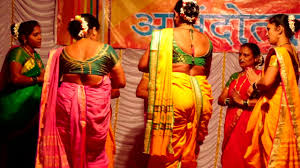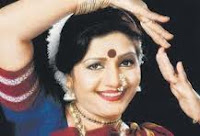Maharashtrian Mangala Gouri Vrat - A traditional games and aerobics
In Mariam Thimma Sagar-MTS Colony, Karwar Road Hubli, Karnataka, during Sravana maasa, Smt. Chhhaya Sunkad mami and other Marathi-speaking mamis (that's how we addressed all regardless of caste, creed, or religion) would wear beautiful Nauvari Maharashtrian sarees, nath-nose pins, jewelry, and chuda-hair tied in a bun. In addition to singing, they would execute what could be described as "kind acrobatics" by twirling, twisting waists, holding hands, and frog-leaping.
The Indian months of July and August, known as Shravana or Sravan Masa, are auspicious times. Married ladies, in particular, practice a ceremony known as Mangala Gouri Vrat. However, Maharashtra is unlike the other Indian states in its unique take on the Mangala Gouri vrataa.
One of the best Vrats, or fasts, is the Shravan Mangala Gauri Vrat, also known as Mangala Gauri puja. Married and single women in Karnataka, Andhra Pradesh, Telangana, and a handful of other states and communities in Maharashtra observe this Vrat. The purpose of this vrat is to ensure the health and happiness of the spouse during the marriage. Worshippers use turmeric powder to create statues of Goddess Parvati, Gauri, or the five pyramids.
There was supposedly a businessman in Maharashtra named Dharampal who was prosperous and whose wife was stunningly gorgeous. They were childless and unhappy, but when they had a son, he was cursed to die from a snake bite when he was sixteen. He married his bride-to-be before she turned sixteen, and her mother was a vrat observer. This girl gave her the gift of never having to worry about being a widow in her lifetime. This allowed the young man she wed to live to be a hundred years old. According to the legend, this fast is essential for the health of a marriage, hence it is recommended that all newlywed women keep it.
In Maharashtra, the Mangal Gowri vrat is performed by newlywed women with the help of more experienced women. Special pujas are held on this day to honour Goddess Gowri. Gowri is a form of the Hindu goddess Durga or Parvathi. This puja is traditionally performed by women dressed in the nauvari sari of the Maharshrian Kachi culture. This ceremony requires newlywed ladies to abstain from food and drink from sunrise to sunset. On this day, women draw elaborate rangolis and decorate the pooja space with flowers and candles. In this ritual, the bride's sisters and mother-in-law are given sixteen laddus as Prasad, which is subsequently given to a Brahmin. After this, aarti is performed in front of the Goddess using sixteen-wick lamps. The idol of the Goddess Gowri is submerged in a pond on the second day of the puja. It is recommended that once begun, this puja be continued for a full five years in order to ensure domestic tranquility and harmony. She then participates in "Mangalgowriche Khel-," which entails singing, dancing, and physical activities, with the women and families of the neighbourhood after she has performed the evening aarti to Mother Gowri. This custom, known as the Shravana Maasa Mangalvar, is typically carried out on Tuesdays of the Shravana maasa. Beginning on the first Tuesday of each month, it runs through the following Tuesday.
They engage in playing traditional games like-‘agota-pagota’, ‘dhanushya’, ‘jhimma’, ‘fugdi’and so on. Women have a significant role in Indian festival celebrations. Women everywhere need the freedom to roam, speak their minds, interact with others, and have fun in the 'Space' that is provided by every culture. Rituals and observations lay the groundwork for these celebrations, which are then topped off with music, dancing, and games. "These were the ritualistic practices followed from the Peshwai period in Maharashtra," explains Dr. Manjiri Ghokale, who maintains a YouTube channel dedicated to the music of Maharashtra. The rationale behind this practice is that it helps to prevent "homesickness" in young brides who might otherwise feel lonely before their wedding day due to the prevalence of child marriage in their culture.







Comments